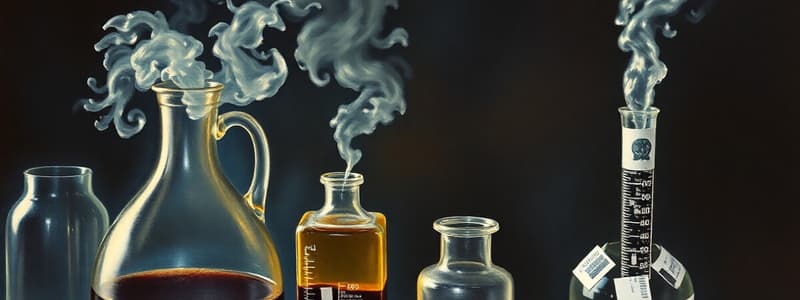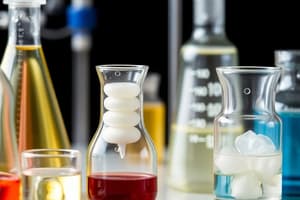Podcast
Questions and Answers
What is the main principle behind separating cream from milk using a centrifugal separator?
What is the main principle behind separating cream from milk using a centrifugal separator?
- Chemical reaction between milk components
- Density difference between cream and milk (correct)
- Evaporation of water content
- Temperature change during spinning
What would likely occur if freshly collected blood is put in a centrifuge?
What would likely occur if freshly collected blood is put in a centrifuge?
- The blood will remain unchanged
- The blood will separate into its components (correct)
- The blood will boil due to heat generated
- The blood cells will dissolve in plasma
What is the purpose of the nozzle in a variant container-separator for milk?
What is the purpose of the nozzle in a variant container-separator for milk?
- To mix the milk and cream together
- To allow the cream to exit first
- To drain the milk from the bottom (correct)
- To introduce air for faster separation
In which order do larger particles end up in the pellet during centrifugation?
In which order do larger particles end up in the pellet during centrifugation?
What is a disadvantage of not using centrifugal separators for cream and milk separation?
What is a disadvantage of not using centrifugal separators for cream and milk separation?
What is the primary function of a separating funnel?
What is the primary function of a separating funnel?
Which technique would be least effective for separating a homogeneous mixture?
Which technique would be least effective for separating a homogeneous mixture?
What happens to particles when a mixture is spun in a centrifuge?
What happens to particles when a mixture is spun in a centrifuge?
Which separation technique utilizes differences in density to separate components?
Which separation technique utilizes differences in density to separate components?
During the centrifugation process, what is the liquid remaining above the pellet called?
During the centrifugation process, what is the liquid remaining above the pellet called?
How can a separating funnel be used effectively to separate oil and water?
How can a separating funnel be used effectively to separate oil and water?
Which of the following methods is commonly used to separate solids from liquids based on particle size?
Which of the following methods is commonly used to separate solids from liquids based on particle size?
What is formed after spinning a mixture in a centrifuge?
What is formed after spinning a mixture in a centrifuge?
Explain how density differences play a role in the separation of milk and cream using a centrifugal separator.
Explain how density differences play a role in the separation of milk and cream using a centrifugal separator.
Discuss the potential effects on blood components when subjected to centrifugation immediately after collection.
Discuss the potential effects on blood components when subjected to centrifugation immediately after collection.
Describe the visual outcome and components of a centrifuge tube after processing a mixture.
Describe the visual outcome and components of a centrifuge tube after processing a mixture.
What are the advantages of using a centrifugal separator over traditional methods for separating milk and cream?
What are the advantages of using a centrifugal separator over traditional methods for separating milk and cream?
How would you describe the operating mechanism of a separating funnel in separating oil and water?
How would you describe the operating mechanism of a separating funnel in separating oil and water?
What is the main purpose of using a centrifuge in separation techniques?
What is the main purpose of using a centrifuge in separation techniques?
How does a separating funnel differentiate between two immiscible liquids?
How does a separating funnel differentiate between two immiscible liquids?
What happens to a mixture when it is centrifuged at a low speed initially?
What happens to a mixture when it is centrifuged at a low speed initially?
What role does floatation play in the separation of materials?
What role does floatation play in the separation of materials?
Can you explain how crystallization fits into the process of evaporation?
Can you explain how crystallization fits into the process of evaporation?
Why is the sedimentation process necessary before centrifugation?
Why is the sedimentation process necessary before centrifugation?
How do magnets aid in the separation of materials?
How do magnets aid in the separation of materials?
What is the effect of shaking oil and water in terms of separation techniques?
What is the effect of shaking oil and water in terms of separation techniques?
Flashcards are hidden until you start studying
Study Notes
Separation Techniques
- Sieving: separates particles of different sizes
- Decanting: separates a liquid from a solid by carefully pouring the liquid off the top.
- Magnets: separates magnetic materials from non-magnetic materials
- Filtration: separates a solid from a liquid using a filter
- Evaporation: separates a dissolved solid from a liquid by heating the mixture until the liquid evaporates, leaving the solid behind
- Crystallization: a specific type of evaporation where the dissolved solid forms crystals as the liquid evaporates
- Distillation: separates liquids with different boiling points by heating the mixture to vaporize the liquid with the lower boiling point
- Chromatography: separates substances in a mixture based on their different affinities for a stationary phase and a mobile phase
Floatation
- Plastic floats on water and can be scooped out with a net.
Separating Funnel
- Separates two immiscible liquids (liquids that don't mix) with different densities
- The less dense liquid floats on top.
- The more dense liquid is drained out of the bottom into a beaker.
- Once the lower layer is removed, the upper layer can be collected in a separate beaker.
Centrifuge
- A machine that creates a rotational force to separate particles by density
- More dense particles form a pellet at the bottom of the tube.
- The remaining liquid (supernatant) can be carefully removed.
- The supernatant can be spun again to separate remaining particles with different densities.
Centrifuge Applications
- Blood Separation: To separate blood into plasma, red blood cells, white blood cells, and platelets.
- Milk Separation: Separating cream from milk.
- Before Centrifugal Separators: Cream was separated by hand skimming, a labor-intensive and time-consuming process.
- Centrifugal Separator Design: Original separators were hand-cranked.
### Separation Techniques
- Sieving
- Used to separate solid particles of different sizes.
- Larger particles are retained on the sieve while smaller particles pass through.
- Decanting
- Used to separate a mixture of a liquid and a solid when the solid is denser than the liquid and settles at the bottom.
- The liquid is carefully poured off, leaving the solid behind.
- Magnets
- Used to separate magnetic materials from non-magnetic materials.
- Filtration
- Used to separate an insoluble solid from a liquid.
- The mixture is poured through a filter paper.
- The solid gets trapped on the paper while the liquid passes through.
- Evaporation (and Crystallization)
- Used to separate a soluble solid from a liquid.
- The liquid is heated until it evaporates, leaving behind the solid.
- Distillation
- Used to separate liquids with different boiling points.
- The liquid with the lower boiling point evaporates first, and the vapor is collected and condensed back into a liquid.
- Chromatography
- Used to separate different substances in a mixture based on their different affinities for the stationary and mobile phases.
- The mixture moves through a stationary phase, and the different substances travel at different rates, allowing them to be separated.
Floatation
- Used to separate less dense solid materials from water.
- Solids float on water and can be scooped with a net.
Separating Funnel
- Used to separate immiscible liquids of different densities.
- The less dense liquid floats on top.
- The separating funnel allows the denser liquid to be drained out from the bottom.
Centrifuge
- A machine that creates a rotational force.
- Used to separate particles of different densities in a mixture.
- The denser particles form a pellet at the bottom of the tube after spinning.
- The remaining solution on top is called the supernatant.
- The supernatant can be spun again at a faster speed to further separate remaining particles.
- The centrifuge is often used to separate blood components, such as red blood cells, white blood cells, and plasma.
- Milk can be separated into cream and milk using a centrifuge based on density differences.
Centrifuge Applications
- Blood Separation: Separating blood into plasma and red blood cells.
- Milk Separation: Separating cream from milk.
- Wastewater Treatment: Separating solid particles from water.
- DNA Isolation: Separating DNA molecules from other cellular components.
Separating Funnel and Centrifuge Notes
- Separating Funnel: A separating funnel is a piece of equipment used to separate two immiscible liquids, such as oil and water. The liquids are poured into the funnel, and the denser liquid is drained out from the bottom.
- Centrifuge: A centrifuge works by spinning a mixture at high speed, forcing the denser particles to the bottom of the tube. The remaining solution is called the supernatant.
- Blood Centrifugation: If you put freshly collected blood in a centrifuge, the red blood cells will form a pellet at the bottom, while the plasma will remain on top.
- Milk Centrifugation: If you put freshly collected milk in a centrifuge, the cream will form a layer on top because it is less dense than the milk.
- Centrifuge Tube: After centrifuging a mixture, the tube will contain a pellet of denser particles at the bottom and the supernatant, or the remaining solution, on top.
Studying That Suits You
Use AI to generate personalized quizzes and flashcards to suit your learning preferences.




